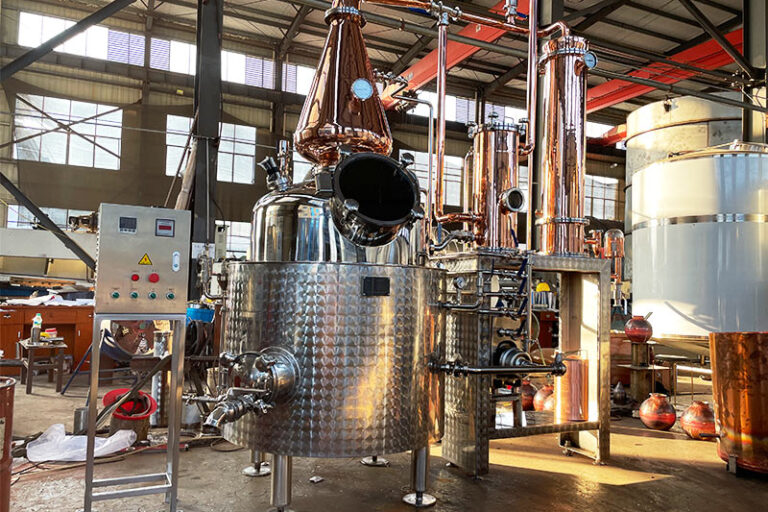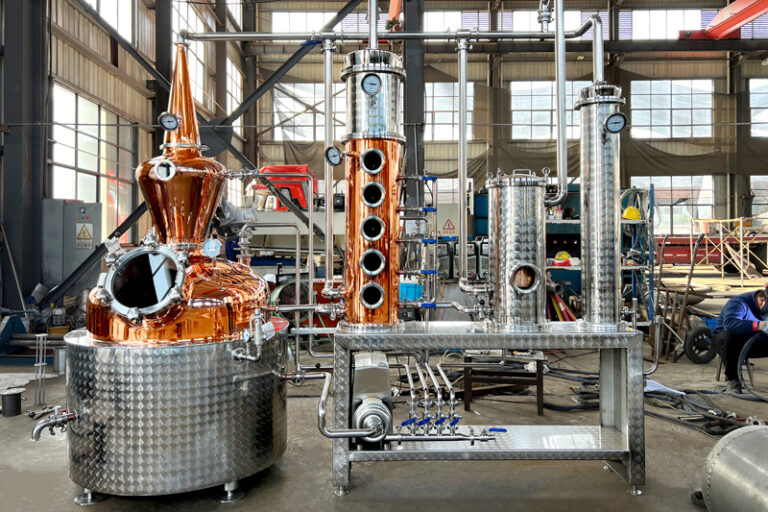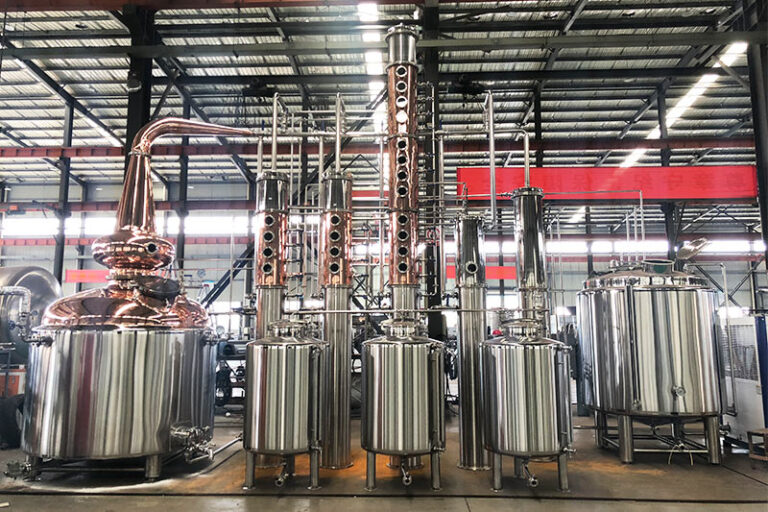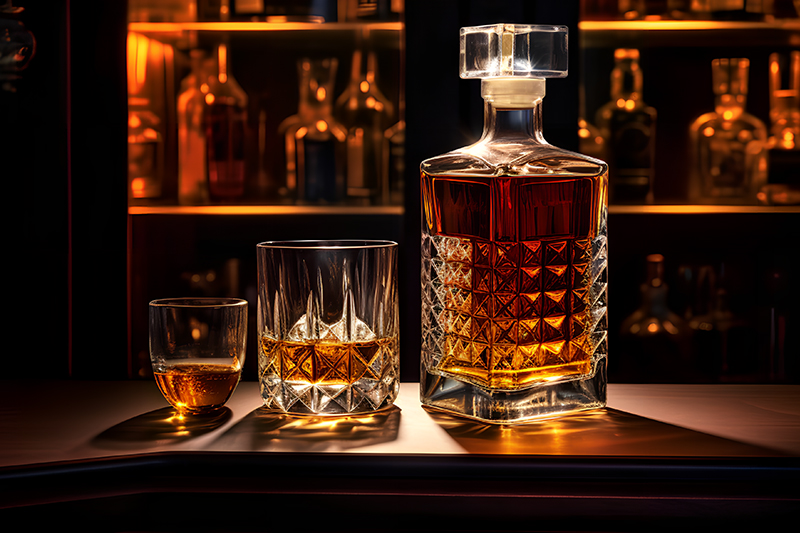Whiskey, a spirit loved by consumers around the world, has a complex flavor and rich layers. Among many spirits, the production process of whiskey is particularly particular. From material selection, fermentation, distillation to maturation, each step affects the final quality. Among them, the distillation process is the key link that determines the style and purity of the liquor.
The production process of distilled liquor
Distillation is a critical step in whiskey brewing. Its function is to extract alcohol from the fermentation liquid, remove impurities, and retain the essence of aroma and flavor. The following is a general production process of distilled liquor:
- Malt production: The raw materials of whiskey mainly include grains, such as barley, corn, rye, wheat, etc. Different grains determine the basic style of theliquor. After the grains are selected, they need to be ground to release starch more easily.
- Mash: Grains are mixed with hot water, and starch is converted into fermentable sugars to form sweet wort (Wort), laying the foundation for subsequent fermentation.
- Fermentation: After the wort is filtered and cooled, yeast is added to start the fermentation process. Yeast converts sugar into alcohol and carbon dioxide to produce a mash (Wash) with an alcohol concentration of about 6% to 10%.
- Distillation: After the fermentation is completed, the mash is introduced into the distillation equipment for heating. Since the boiling point of alcohol is lower than that of water, alcohol and aroma substances will evaporate first, and then cool into liquid through a condenser. Traditional whiskey usually needs to be distilled twice, the first time to extract the original liquor, and the second time to further purify and segment to obtain a higher alcohol concentration and ideal flavor.
- Maturation: The colorless new liquor after distillation needs to be matured. During this process, the color of the liquor gradually darkens. After maturity, different liquors can be blended to create a more layered flavor.
- Filtration and bottling: The matured whiskey needs to be filtered to remove impurities. Some brands choose cold filtration to ensure a clear appearance. After that, deionized water is usually used to adjust the alcohol content to the drinking level, and finally filled into bottles, labeled and sold, and go to the market.

Types of distillation equipment
There are many kinds of distillation equipment, and the structure and function determine the applicable scenarios and the way it affects the flavor. Common distillation equipment is divided into the following categories:
Pot Still
Pot Still is the most common equipment in traditional whiskey production, especially in Scottish single malt whiskey.
- Structural features: The pot still is shaped like an onion and consists of a boiler, a neck, and a condenser. After the mash is heated in the pot, the alcohol vapor sublimates through the neck and condenses.
- Advantages: It retains more flavor substances and is suitable for brewing whiskey with rich flavor and complex layers.
- Disadvantages: Low efficiency, manual cleaning is required, and re-feeding is required after each distillation.
Column Still
Also known as Coffey Still, it is a highly efficient equipment commonly used in industrial brewing.
- Structural features: It consists of two or more columns, which can continuously input fermentation liquid and output alcohol.
- Advantages: High efficiency, suitable for large-scale production; the distilled alcohol is pure, suitable for blended whiskey.
- Disadvantages: Less aroma extraction, not as good as pot stills in retaining complex flavors.
Hybrid Still
Combining the advantages of pot still and column still, the structure is usually a small column part superimposed on the pot still.
- Structural features: integrated design, which not only retains the flavor characteristics of the pot still, but also improves the efficiency of the column still.
- Advantages: Suitable for flexible use by small distilleries and suitable for different styles of whiskey.
- Disadvantages: complex structure and relatively high initial investment.
Mini Still
A small device is suitable for brewing enthusiasts or beginners.
- Structural features: small size, easy operation, often used for experimental distillation.
- Advantages: Affordable price, suitable for learning and small batch production.
- Disadvantages: Low output, limited flavor control.
Multi-purpose Still
A Multi-purpose Still is a highly modular device that can replace different parts according to needs to achieve the distillation of various spirits from fruit wine and brandy to whiskey.
- Structural features: usually adjustable tower section or removable condenser structure, allowing the distiller to adjust the path and distillation stage, and some equipment is also equipped with temperature and flow rate control modules.
- Advantages: Highly adaptable and suitable for the production of a variety of alcohols; very suitable for R&D laboratories or small breweries looking to expand their product lines.
- Disadvantages: Requires certain technical experience for adjustment, and the price is slightly higher than ordinary equipment.
Automatic Distillation Equipment
Automatic distillation equipment is the product of technological progress in recent years. It realizes automatic adjustment and monitoring of temperature, pressure, and flow rate through the digital control system.
- Structural features: equipped with intelligent operation interface, can set distillation program, automatically execute heating, segmentation, condensation, recovery, and other processes, often equipped with data acquisition system.
- Advantages: easy operation, greatly reducing human errors; improved production efficiency, suitable for standardized and branded production.
- Disadvantages: The equipment cost is high, and repair and maintenance require professional support. It is suitable for large and medium-sized breweries with sufficient funds and pursuit of efficiency.

How to use distillation equipment to produce whiskey?
- Preparation: Clean the distillation equipment to ensure that there is no odor or impurities. Check whether all connecting parts are tight to prevent steam leakage.
- Prepare the “wash”, that is, the alcohol liquid after fermentation, with an alcohol content of about 7-10%.
- First distillation (primary distillation): Pour the wash into the pot and heat it to 78-85℃. The alcohol and some volatiles evaporate and enter the condenser through the gooseneck tube. The “fore distillation” part is discarded during the distillation process.
- Second distillation (re-distillation): Heat and distill the “low alcohol” again.
- Accurate fractionation:
- Foreshots: Contains ingredients that are not suitable for drinking and need to be discarded.
- Hearts: The core part of the alcohol, with a strong flavor, is the alcohol liquid used for maturation.
- Feints: The alcohol content decreases and the flavor is poor, which can be retained and returned to the furnace for distillation again.
- Cooling and collection: Use a condenser to cool the steam and collect the alcohol liquid into a container. You can use an alcohol meter to test the alcohol concentration to ensure product quality.

How to choose the right distillation equipment according to your needs?
Choose according to the production scale
Homebrewers or small distilleries can choose tabletop distiller or medium-sized pot still, which is suitable for small batch production or flavor experiments. For large-scale production, a continuous distiller is the best choice, which can achieve efficient and continuous production and is suitable for the needs of commercial distilleries.
Choose according to flavor goals
If you pursue traditional, complex flavors, pot stills are the first choice, which can better retain flavor substances. If you prefer a light, refreshing body, continuous stills are suitable for removing impurities and improving alcohol purity. Hybrid or multi-functional equipment is suitable for trying a variety of flavors and innovations.
Choose according to budget and space conditions
Home brewers with limited budgets can choose tabletop equipment, which is affordable and easy to operate. For commercial breweries with sufficient budgets, fully automatic distillation equipment can provide higher production efficiency and consistency, suitable for large-scale production. When space is limited, small equipment is more suitable.

FAQ
What is distillation equipment?
Distillation equipment is a device used to separate the components in a liquid through a heating and cooling process. In whiskey production, distillation equipment is mainly used to extract alcohol components from fermented broth.
How long does it take to produce whiskey using distillation equipment?
From brewing to distillation, the entire whiskey production process may take a few days to a few weeks. However, the distillation process itself usually takes only a few hours to a day. It is worth noting that the final flavor of whiskey is also affected by the long aging process, and it usually takes several years to reach the best taste.
Does distillation equipment require regular maintenance?
Yes, distillation equipment needs to be cleaned and maintained regularly. The surface of copperware is easily affected by sulfides and other impurities, so cleaning is essential. The pipes, pots, and cooling systems of distillation equipment also need to be checked regularly to ensure a smooth distillation process.
What is the investment cost of distillation equipment?
The investment cost of distillation equipment is usually high, especially for high-quality copper pot stills. The design, material, and size of this equipment will affect the price. For small breweries, the initial investment may require considerable capital investment, but for large-scale production, equipment investment is a necessary foundation.

